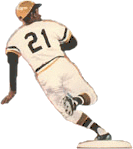
By 1960, Clemente had emerged as a star, achieving personal bests in runs, home runs, RBI, and batting average. He hit .310 as the Pirates won the World Series, then raised his game another notch in 1961, hitting .351, the first of five times he hit over .340. Roberto won four batting titles, hit 240 homers, and was the National League MVP in 1966.
Clemente’s arm was a deadly cannon that he unleashed from impossible angles and distances. The power and accuracy with which he threw is legendary. He won Gold Gloves every year from 1961 to 1972 and played more games in right field than anyone else in history.
Although Clemente suffered from a myriad of injuries throughout his career, he posted the top batting average of the 1960s at .328. Clemente batted .312 in 1972, at age 38, and rapped his 3,000th hit on September 30th. Sadly, it was his last.
On December 31, 1972, he was on a plane airlifting supplies to earthquake-torn Nicaragua. The plane crashed near the Puerto Rico coast; there were no survivors. Clemente was voted into the Hall of Fame in an extraordinary special election held just 11 weeks after his death.

When he retired after 24 big-league seasons, Cobb held almost every major league batting and base-running record.
Cobb won ten batting titles, led the league in runs scored five times, RBI four times, slugging percentage eight times, and on base percentage six times. His total of 4,191 hits and 892 stolen bases are the second and third highest totals ever. Cobb was the dominant player of his day, but to his regret, never played on a World Series winner.
He was fired as the Tigers player-manager following the 1926 season after it was discovered that he and Tris Speaker had apparently rigged a 1919 game. It was foreordained that Detroit would win; Cobb couldn’t ever agree to finish less than first in anything.
Cobb signed with the Philadelphia Athletics and retired after the 1928 season. For the next 33 years he lived on the terms under which he had played - comfortable, but essentially alone.
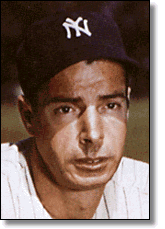
DiMaggio batted .341 in 1934, and the Yankees paid $25,000 and five players for Joe. Assigned back to San Francisco for 1935, DiMaggio batted .398 with 34 homers and 154 RBI.
DiMaggio hit big in Gotham in 1936, helping the Yankees to the first of four consecutive World Series Championships. Although hampered by Yankee Stadium’s cavernous left field, the Yankee Clipper twice led the AL in homers and twice in slugging. He was fast, strong and smart on the field.
Joltin’ Joe played center with grace and threw with terrific power. He paced the league with 22 assists in 1936, then notched totals of 21 and 20 before opponents stopped running on him.
He won his first MVP Award in 1939 with a career best .381 average. When he won his second trophy in 1941, he had 76 walks and only 13 strikeouts. DiMaggio also hit in a record 56 consecutive games, a feat that has never been matched.
World War II deprived Joe of three seasons. In 1947, he won his third MVP and the Yankees won another Championship. A heel injury slowed Joe in 1948. He returned in 1949 to help the Yankees win the first of five straight World titles, but injuries and the grind of the road led DiMaggio to retire after the 1951 season.

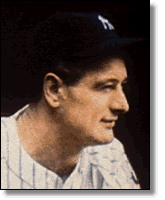
Born in Manhattan, Henry Louis Gehrig (1903-1941) started his pro career in 1923. After two years in the minors, he moved to New York for good. In 1925, his first full major league season, Gehrig hit .295 with 68 RBI. He never again scored or drove in under 100 runs in a full year.
In 1931, Lou established an AL record with 184 RBI, breaking his own mark of 175. He also once had three triples in a game that was rained out - in the fourth inning!
Gehrig’s slugging exploits were only part of the story. He was also both an excellent base runner and a solid first baseman. His two MVP Awards were given in recognition for Gehrig’s contributions to a great Yankees team.
In 1934, Gehrig won the Triple Crown - his only batting title. Gehrig slumped badly in 1938 and early 1939. Lou benched himself on May 2, sitting out for the first time in nearly fourteen years. Shortly afterwards, tests revealed that he had amyotrophic lateral sclerosis - a terminal hardening of the spinal cord. Knowing he would soon die, Gehrig retired on July 4, 1939, at Yankee Stadium. Tearfully he told the packed house,
“Today, I consider myself the luckiest man on the face of the earth.”
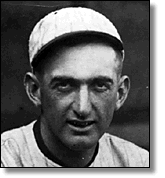
Joseph Jefferson Jackson (1887-1951) signed with Philadelphia, but the largely uneducated Jackson felt uncomfortable with the big-city life and he was soon released. He fared better in Cleveland, where he stayed until early 1915, when he was sold to the White Sox.
For a four year stretch Jackson averaged better than .300. In 1911 he batted .408, and the next season hit .395, but finished second to Ty Cobb both times. Joe compiled a tremendous .356 lifetime average, third only to Ty Cobb and Rogers Hornsby.
In 1919 AL champion White Sox were favored to beat the Reds in the World Series, but lost five games to three. Accusations flourished concerning the performance of several Sox players. During the 1920 season, eight players, including Jackson, were charged with accepting bribes to throw the Series. The accused players were banned from baseball for life.
Jackson, who batted .356 in 1920, his final season, maintained his innocence until his death. In the 1919 Series, he topped all players with a .375 average, but committed two costly errors in the field.
After being banned, Jackson returned to South Carolina. He played for semipro teams under assumed names and lived comfortably. His supporters have made continuous but unsuccessful attempts to convince the baseball establishment that Jackson belongs in the Hall of Fame.
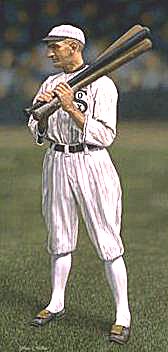
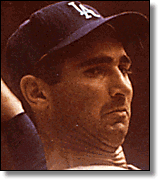
Koufax, born in Brooklyn in 1935, signed with his hometown Dodgers in 1954. He started only five games in 1955, alternately brilliant and completely wild. The Dodgers moved to Los Angeles before the 1958 season, and Koufax was 27-30 over the next three years. He threw hard with excellent movement, but had not yet learned how to pitch.
Early in 1961, catcher Norm Sherry urged Koufax to slow down and throw changeups and curveballs. Following that advice, Sandy went 18-13 and led the league with an eye-popping 269 Ks. In 1962, the Dodgers moved to Dodger Stadium and Koufax was 14-7 with a no-hitter and a league leading 2.54 ERA, though he missed time with a finger ailment.
A healthy Koufax returned in 1963. He went 25-5, leading the NL with a 1.88 ERA, eleven shutouts, and 306 strikeouts. He won both the MVP and Cy Young Awards, tossed another no-hitter, and won two games in the World Series. In 1964, he was 19-5 with a league best 1.74 ERA, but was shelved by a deteriorating arthritic condition in his arm. He pitched in 1965 and 1966, aided by cortisone shots and ice, and won two more Cy Young Awards. He collected 26 and 27 wins and league best ERAs of 2.04 and 1.73. Koufax also tossed two more no-hitters, including a perfect game.
The Dodgers won NL crowns in 1963, 1965, and 1966, mainly due to his brilliance. One of the best pitchers ever while at his peak, Koufax has kept a low profile since being voted into the Hall of Fame in 1972.

The Yankees signed Mickey, originally at shortstop, in 1949. The next year, he led the Western Association with a .383 batting average, 141 runs, 199 hits, and 55 errors.
Mickey opened the 1951 season in right field with the Yankees, but was soon sent to the minors. Mickey’s dad persuaded him not to give up, and he soon returned.
Mickey eventually took over in center field for Joe DiMaggio in 1952. “The Commerce Comet” led the Yanks to seven World Championships and owns records for homers, RBI, runs, walks, and strikeouts in Series play. He won his first of four homer titles in 1955.
In 1956, Mantle won a triple crown with 52 homers, 130 RBI, and a .353 average. He also captured the first of three MVP Awards. He won again in 1957, hitting .365 with 34 homers, 94 RBI, 121 runs, and 146 walks.
Mantle notched homer records in 1958 and 1960, then dueled with Roger Maris to break Ruth’s record in 1961. While Maris won with 61, Mick hit 54, and led the AL with a .687 slugging percentage, 132 runs scored, and 126 walks. Mick again won an MVP in 1962.
Mantle’s many injuries shortened his career.After two painful seasons in 1967 and 1968, The Mick retired with 536 home runs. Mantle was inducted to Cooperstown in 1974.
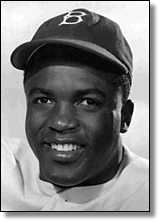
Jack Roosevelt Robinson (1919-1972) starred in four sports at UCLA and attracted the attention of Brooklyn Dodger GM Branch Rickey. After an Army stint, Robinson joined the Negro league’s Kansas City Monarchs. Rickey sought out and signed Robinson expressly to break baseball’s color barrier. Aside from his outstanding baseball skills, Jackie possessed a strong and unbending character. From the beginning Jackie was everything Rickey wanted.
Robinson broke in with Montreal of the International League in 1946. In 1947, Robinson was Rookie of the Year playing first base for Brooklyn. He later recalled the lowest day of that year being his first visit to Philadelphia, where “hate poured forth from the Phillies dugout.” Jackie said he was never closer to quitting.
Robinson didn’t quit though. Instead, he took the next step, winning a batting title in 1949 at .342 and capturing the MVP Award. Though he played just ten seasons, he helped the Dodgers to six World Series. The most devastating base runner of his day, he also had dangerous power and fanned only 291 times in over 5,000 plate appearances. He became the first African-American elected to the Hall of Fame in 1962.
The Reds signed 140 pound Cincinnatian Peter Edward Rose (born 1941) in 1960. He spent the off season pumping iron, and led in runs, hits, and triples his next two years in the minors.
Rose debuted in 1963 as Cincy’s second sacker, and his enthusiasm endeared him to hometown fans. Taking a walk, he dashed to first emulating Enos Slaughter; Whitney Ford dubbed Rose “Charley Hustle.” Rose’s .273 batting average and 101 runs scored won him the Rookie of the Year Award.
Rose came back in 1965 to lead the NL in hits and putouts. He was named to his first of seventeen All-Star teams. In 1967 the Reds moved Rose to the outfield, and in 1968 and 1969 he captured batting titles.
Rose led the “Big Red Machine” to four World Series between 1970 and 1976. In 1973, he batted .338 and won the NL MVP. He amassed a forty four game hitting streak in 1977, and collected hit number 3,000 the next year.
Rose signed with Philadelphia and played on the 1980 World Championship squad. He finished his career as a player manager in 1986, compiling a .303 lifetime average.
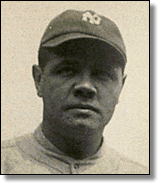
In 1919, George Herman Ruth (1895-1948) set a new mark with 29 home runs. However, Boston owner Harry Frazee’s financial needs prompted Ruth’s sale to the New York Yankees. “The Sultan of Swat” brought $100,000, over twice the price of any previous player.
Ruth took New York, baseball, and America by storm in 1920. His fifty four home runs were more than any other AL team hit. His .847 slugging percentage is still a single season record, and he batted .322 with a league leading 158 runs and 137 RBI. He led the AL in home runs 12 times, runs scored eight, and RBI six. He paced the AL in slugging percentage thirteen times. His sixty four baggers in 1927 and 714 career home runs stood as records for over thirty years. The Babe led the Yankees to four World Championships, helping to initiate a popular new offense baseball that helped heal the wounds left by the 1919 Black Sox scandal.
He might have won more honors, but was suspended in 1922 for barnstorming, and played only 98 games in 1925 due to an intestinal abscess. The Bambino led the league in walks eleven times, drawing a record 170 in 1923. He was a fast runner, became a fine outfielder, and could have been an immortal pitcher. Beyond his on field heroics, Ruth - one of the first five inductees in 1936 - was a legend for his off the field adventures as well. His appetite for life led him to every excess. He ate everything, drank everything, tried everything and made friends everywhere. Ruth was the most beloved man ever to play the game.
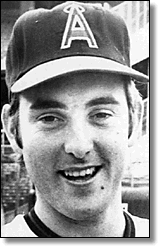
The New York Mets drafted Lynn Nolan Ryan (born 1947) in 1965. He reached the majors permanently in 1968 and was a key member of the “Miracle Mets,” setting an NLCS record for most strikeouts by a reliever. Ryan was traded to the Angels in 1971 for Jim Fregosi. In 1972, he was 19-16 with a league leading 329 Ks. In 1973, he threw two no-hitters, set a single season record with 383 strikeouts, and collected his first 20-win season. His heater picked up the “Ryan Express” appellation in reference to the film Von Ryan’s Express. During his eight seasons with California, he led the American League in strikeouts seven times (and in walks on six occasions). In 1980, Ryan signed a free-agent deal with the Houston Astros to be close to his Texas home. Nolan thrived at the Astrodome, pacing the National League with a 1.69 ERA in 1981. He also led the loop in ERA and strikeouts in 1987, but finished just 8-16 due to poor support. In the 1980s he improved his control significantly, going from a high of 204 walks in 1977 to totals under 100 over his last ten years. He signed with Texas in 1989, and pitched for the Rangers for the remaining five seasons of his career.
Ryan, the only pitcher with three straight seasons of 300 or more strikeouts, is also the sole major league hurler with more than four no-hitters. He tossed his fifth on national television in the heat of the 1981 pennant race. His seventh gem came in 1991 against the Toronto Blue jays, when Ryan was 44 years old. He won 11 strikeout crowns, finished with a total of 5,174 Ks, and threw bullets until the day he retired in 1993.
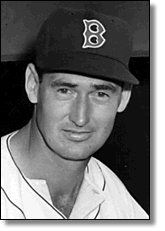
Born in 1918 in San Diego, Theodore Samuel Williams was inked by the Red Sox in 1938. The brash youngster won the American Association Triple Crown with a .366 average, 43 homers, and 142 RBI.
In 1939, Williams made an immediate impact in Boston, hitting .327 with 31 home runs and a league leading 145 RBI. In 1941 he hit .406; nobody has cleared .400 since. In 1942, Williams produced his first Triple Crown, with a .356 average, 36 home runs, and 137 RBI, only to finish second in the MVP voting.
Williams lost three years to World War II serving as a pilot with the marines, but returned in 1946 to win his first MVP Award. Ted captured his second Triple Crown in 1947 but was again denied the MVP. The “Splendid Splinter” won the batting crown in 1948 and another MVP in 1949. Hitting .343 with a league leading 43 homers, 159 RBI, 150 runs, and 162 walks.
Ted spent most of 1952-1953 fighting in Korea. He again won batting crowns in 1957 and 1958. Williams retired after the 1960 campaign, homering in his last big league at bat.
His .483 on-base-average is the highest ever, and in five seasons he reached base over half the time. Ted also owns the second best slugging average and 521 home runs. He did all this despite missing five seasons to war. “Teddy Ballgame” was inducted into Cooperstown in 1966 and managed the Washington Senators from 1969 to 1974.
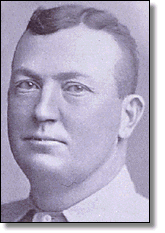
Denton True Young (1867-1955) joined the Cleveland Spiders later that year. Cap Anson, player manager of the Chicago White Stockings, rejected Young earlier that year as being “just another big farmer.” After Cy beat Chicago in his first major league outing, Anson tried in vain to purchase him.
Throughout the 1890s, Young was the top pitcher in the game, blending stamina, guile, and excellent control. However, when attendance sagged in Cleveland, Young and most of the team’s other stars were shipped to St. Louis in 1899.
Turning 33 in 1900, Young registered just 19 wins, his lowest output since his rookie season. Cy then signed with Boston in the new American League. Rumors of Young’s decline were dispelled as he led the yearling major league in wins in 1901, then repeated his feat the next two years.
Cy won 20 or more games six times for the Boston Americans and participated in the first World Series in 1903. Perhaps the finest effort of his career came on May 5, 1904, when he pitched a perfect game against Rube Waddell and the Philadelphia Athletics.
Young retired in 1911 with 511 career victories, 7,257 innings pitched and no sore arm. Cy was inducted into the Hall of Fame in 1938. Shortly after Young’s death, Commissioner Ford Frick originated the Cy Young Award, an annual honor bestowed upon the pitcher deemed most valuable in each league.

